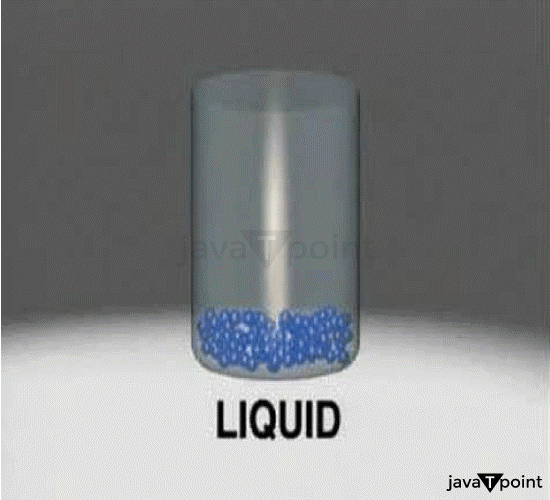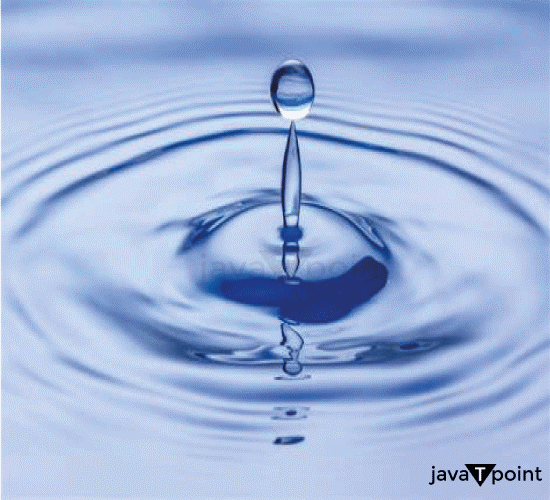Definition Of LiquidA liquid is a condition of matter that lacks a set form but has a known volume. The container in which it is held determines its form. Intermolecular forces keep the molecules in a liquid from dispersing despite their continual motion. Liquids may flow and adopt the shape of their container because these forces, which are less than those which bind the molecules of solids together, allow for this. 
Depending on the type of molecular structure they possess, liquids can be categorized as either polar or nonpolar. Water and other polar liquids include molecules with a separation of charge or a positive and negative end. Oil and other nonpolar liquids have molecules without charge separation. The kind of intermolecular forces governs the characteristics of liquids, including viscosity, surface tension, and boiling temperature. The intensity of the intermolecular forces determines the viscosity, which is a measurement of a liquid's resistance to flow. Surface tension, a measurement of the force needed to break a liquid's surface, is also influenced by the strength of the interactions between molecules. Evaporation, which happens when molecules at a liquid's surface have enough energy to overcome intermolecular interactions and escape into the air, is a process that allows liquids to transform into gases. The liquid's surface area, pressure, and temperature all have an impact on this process. Since they are the principal medium in which many biological processes take place, liquids are crucial to life as we know it on Earth. They are also employed in several commercial and industrial processes that create chemicals, fuels, and medications. States Of MatterThere are three primary states of matter- solid, liquid, and gas. Every state has particular qualities and traits that are exclusive to it. A form of matter known as a solid has a constant form and volume. Strong intermolecular forces hold the molecules in a solid's densely packed structure in place. Solids possess this stiffness and deformation resistance. Solids can be amorphous, like glass, or crystalline, like salt or diamond. Another form of matter known as a liquid has a known volume but no set form. Although the molecules in a liquid are always in motion, there are lower intermolecular forces than there are in a solid. Liquids can then flow and conform to the shape of their container as a result. Water and oil are both examples of polar liquids. A form of matter known as a gas lacks a definite form or volume. In a gas, the molecules are constantly in motion and far apart from one another. Gases are hence very compressible and have the ability to expand to fill their container. Depending on the makeup of their molecules, gases can be categorised as either ideal or actual. There are more states of matter that exist in severe circumstances in addition to these three primary ones. High-temperature plasma is a matter condition characterised by ionised particles that conduct electricity. Bose-Einstein condensate is a type of state of matter that develops at very low temperatures and is characterised by the fusion of distinct quantum states. A material's temperature and pressure determine the state of matter the substance is in. A material can transition from one condition to another by being exposed to changes in temperature or pressure. For instance, a solid may melt into a liquid when heated, and gas may condense into a liquid when cooled. Our understanding of the many states of matter plays a crucial role in how we perceive the physical world and is the foundation for several scientific and technological developments. Knowledge of the states of matter is essential for advancement in many domains, ranging from studying materials science to creating novel medications. Properties Of LiquidThe condition of materials known as liquids has special qualities and traits. Among the essential characteristics of liquids are the following:
Various Usage Of LiquidA material that is often utilised in many facets of daily life is liquid. It is a kind of substance that takes on the shape of its container while having a fixed volume but no fixed shape. There are many different types of liquids, such as water, oils, and alcohol.

Importance Of LiquidWater is a substance that all living things require to survive. It is an essential part of biological activities in various species, including bacteria, plants, and mammals. A large amount of an organism's body is made up of water, which is also essential to numerous processes that maintain the organism's life.
Composition Of LiquidsA liquid is a condition of matter that lacks a set form but has a known volume. It is made up of molecules, which are very little pieces that are continually moving and interacting with one another. The sorts of atoms and molecules that make up a material, such as a liquid, define the composition of the liquid. The atoms and molecules that make up the liquid are connected by chemical bonds, which govern the liquid's physicochemical characteristics. A liquid's chemical formula, which lists the kinds and counts of atoms and molecules it contains, can be used to explain the composition of the liquid. For instance, water is made up of two hydrogen atoms and one oxygen atom, as shown by its chemical formula, H2O. The molecular structure, which describes how the atoms and molecules are grouped in the material, may be used to characterise the chemical makeup of a liquid in addition to its chemical formula. This can all impact the boiling point, viscosity, and density of the liquid. ConclusionIn conclusion, a liquid is a state of matter that has a set volume but no fixed shape and can take on the shape of its container. Liquids have the capacity to flow and have a propensity to take on the shape of the container they are contained in. Their surface tension, viscosity, and adhesion characteristics can affect how they behave and how they interact with other substances. In addition, liquids' molecular structure enables them to have a relatively high level of kinetic energy, which is what gives them their fluidity and capacity for movement. Liquids can change shape and flow freely in response to external influences because they do not have a set arrangement of molecules as solids do. Additionally, liquids may be divided into other groups depending on their chemical features, such as polar and nonpolar liquids, which differ in terms of how they interact with other substances. Additionally, liquids can change their characteristics and behaviour as a result of different phase transitions like boiling and freezing. Overall, the concept of a liquid is crucial to our comprehension of matter and has a wide range of real-world applications in disciplines like chemistry, physics, and engineering.
Next TopicOsteoarthritis Definition
|
 For Videos Join Our Youtube Channel: Join Now
For Videos Join Our Youtube Channel: Join Now
Feedback
- Send your Feedback to [email protected]
Help Others, Please Share










